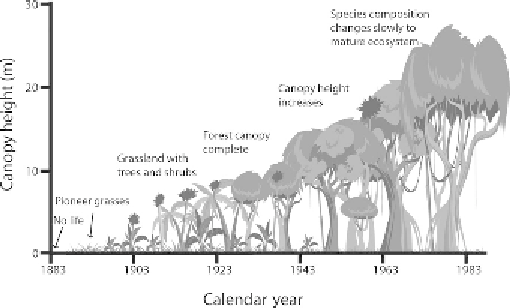Environmental Engineering Reference
In-Depth Information
Figure 17.5 Ecological recovery of
flora following destruction by ash depos-
ition from the 1883 eruption of Krakatau in Indonesia (modi
ed from Bush,
2006
).
17.3 Oceanic ash deposition
17.3.1 Physical effects
Ash particles can affect marine ecosystems through light shading and thinning
of the euphotic zone (
Figure 17.3I
). In the open ocean this effect is limited by the
rate of settling through the water column, a process that appears to be rapid
(Wiesner
et al
.,
1995
). However, in coastal ecosystems the remobilization of ash
by tides, waves and currents can continue to inhibit photosynthesis (
Figure 17.6
).
This effect would be extremely long-lived in scenarios where the erosion of a
terrestrial ash blanket affects benthic coastal ecosystems, such as coral reefs,
previously unaccustomed to high sediment
fluxes. The settling of particles through
the water column may have a transient effect on planktic
flora and fauna,
by becoming tangled in the mucus nets of pteropods (Wall-Palmer
et al
.,
2011
),
by affecting micro-organism buoyancy, by clogging the gills of
fish or by affecting
larger
filter-feeding animals such as whales (
Figure 17.3J
).
17.3.2 Fertilization
The growth of phytoplankton (the dominant marine primary producers) will
continue unabated in sunlit areas until the water becomes de
cient in one or
several ingredients, commonly N, P or Fe. Ash surface coatings contain abundant
macro- (N, P, Si) and micro-nutrients (e.g. Fe, Mn, Zn) integral to photosynthesis
and other biological processes. The release of these elements can therefore poten-
tially increase primary productivity (
Figure 17.3K
). It has been suggested that the

